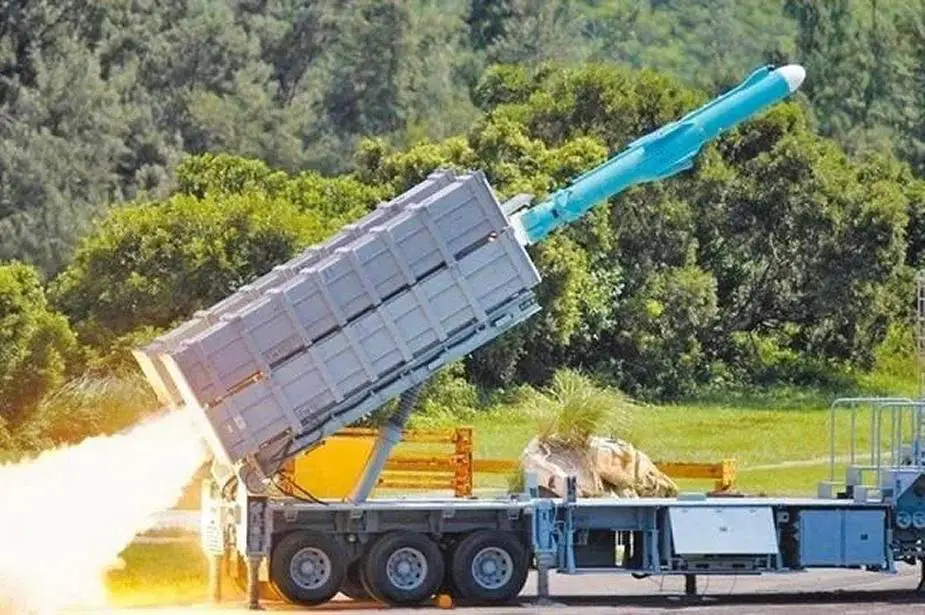According to Radio Free Asia on Friday, August 19, the Taiwanese state-run National Chung Shan Institute of Science and Technology (NCSIST) conducted a series of live-fire missile tests on Thursday and Friday as a Chinese warship sailed near the island’s east coast, local media reported.
Follow Army Recognition on Google News at this link

Firing of a Hsiung Feng II cruise missile (Picture source: NCSIST)
The National Chung Shan Institute of Science and Technology (NCSIST) test-fired Hsiung Sheng surface-to-surface cruise missiles into the eastern waters of Taiwan from the Jiupeng military base in Pingtung County, according to a report by the official Central News Agency (CNA).
Just hours before the test began, a Chinese guided-missile destroyer was spotted 60 kilometers (37 miles) northeast of Green Island, Taitung County. Green Island is only over 30 kilometers (19 miles) from Taiwan’s main island and, together with Orchid Island, is included in the “danger zone” of the projectiles which extends about 200 kilometers (124 miles) off the coast of Taitung.
The NCSIST announced last month that it would conduct two rounds of missile tests on Aug. 18-19 and Aug. 25-26. The missiles have an "unlimited" projectile altitude, meaning they are medium and long-range.
The Hsiung Sheng cruise missile is an improved variant of Taiwan’s homegrown Hsiung Feng 2-E missile and has a reported range of up to 1,200 kilometers (746 miles), making it capable of striking targets in Chinese cities as far as Qingdao.
The Hsiung Feng IIE (HF-2E; lit. 'Brave Wind IIE Cruise Missile') is a surface-to-surface cruise missile. The baseline HF-2E Block I land attack cruise missile (LACM) is said to be powered by an indigenously-developed Taiwanese turbofan engine believed to be rated in the 800 lbf (3.6 kN) thrust range and developed by CSIST partially based on technology and experience from the Microturbo 078 turbojet engine used on Hsiung Feng 2 (HF-2) anti-ship cruise missiles. When equipped with a standard unitary high-explosive 1,000 lb (450 kg)-class warhead, it is said to have a maximum range of 700 km. Other types of warheads are said to be in development, such as cluster submunitions and a hard target penetrator warhead. TDR also reported that through modification of the existing engine and combined with the redesign and reduction of the missile's control and electronic systems, CSIST was able to free up enough internal space/weight in the missile to allow it to carry additional fuel and extend its range to over 2,000 km, although a Defense News report claimed the other version was only an 800 km range missile. The ultimate objective is to develop a missile that has an objective range of over 5,000 km (3,100 mi), using a technologically advanced Taiwanese power plant with superior fuel efficiency and mission endurance, and possibly a more advanced and lighter miniaturized warhead.
The HF-2E Block I missile uses inertial guidance with Global Positioning System (GPS) and TERCOM updates. For terminal guidance, it uses infrared homing (Imaging infrared) with an autonomous digital target recognition system. The IIR terminal seeker is used for target acquisition and to positively identify an optimal aim point. The target image is then compared against digitized files in the memory of the onboard guidance computer (DSMAC terminal guidance). The HF-2E block I missile's cruising speed is high subsonic, typically in the Mach 0.75 – Mach 0.85 (571–647 mph; 919–1,041 km/h) range. When the missile approaches hostile territory, it would descend to an altitude of about 15–30 m (49–98 ft). On its final approach to its target, the missile would climb up to avoid any physical barriers and to allow its IIR seeker to acquire the target and identify an optimal aim point before plunging down onto the designated impact point. The report in Taiwan Defense Review, credited the HF-2E block I missile with a pre-terminal accuracy of around 15 m.














